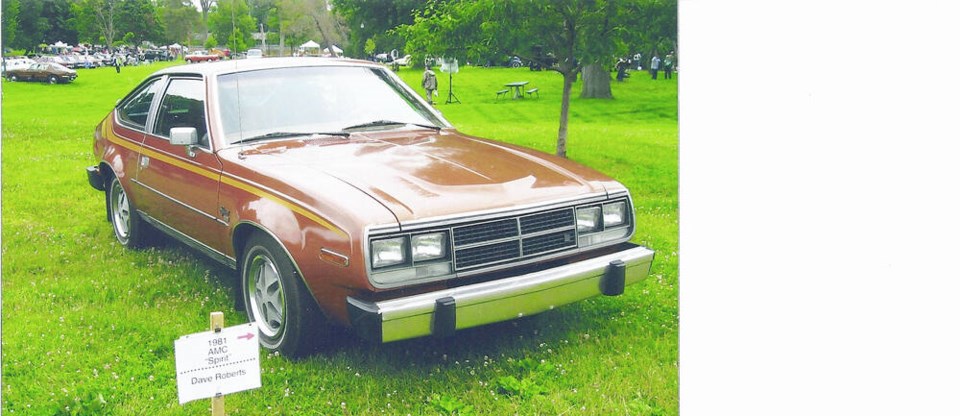As the 1970s progressed, American Motors Corp.’s fortunes declined. It had been formed by the amalgamation of Hudson and Nash in 1954 and thanks to its compact Rambler, had enjoyed a few good years outlasting Studebaker, Packard and Kaiser-Frazer.
AMC’s talented president and dedicated smaller car advocate George Romney left in 1962, became governor of Michigan and would become a U.S. presidential candidate.
Under new president Roy Abernethy, AMC tried unsuccessfully to go head-to-head with the Big Three (General Motors, Ford and Chrysler). Chief stylist Richard Teague became a legendary master at transforming old models into new ones, but AMC was still mostly the industry underdog.
Fortunately it had acquired the Jeep utility vehicle line from Kaiser Industries in 1970, and by decade’s end Jeep was sustaining the company.
AMC discontinued its slow-selling full size Ambassador in 1976 and Matador in 1978, by which time corporate sales had fallen to less than one per cent of the market.
To counter relentless domestic and foreign competition AMC began emphasizing smaller, more elegant cars. The first step was the 1975 Pacer “glass turtle.” For 1978 it reincarnated the Hornet as the more luxurious compact Concord (the Hornet had already metamorphosed from the Rambler in 1970). And for 1979 it revamped the sub-compact Gremlin (created in 1971 by truncating the Hornet) into our subject, the Spirit.
Not surprisingly the Spirit bore a striking resemblance to the Gremlin, although stylist Teague tried to camouflage it with some altered sheetmetal. The new Liftback model got a slant-back rear profile while the two-door sedan had a more abrupt chopped off “Kammback” treatment.
Rear side windows were enlarged and reshaped, improving both visibility and appearance. For the youth market, an optional sporty version of the AMX Liftback included tuned suspension, anti-roll bars, stronger brakes and “Turbocast” wheels.
The quite compact Spirit’s wheelbase of 2,438 mm (96 in.) and length of 4,237 mm (166.8 in.) was about the same size as Chrysler’s recently introduced Dodge Omni/Plymouth Horizon. But the Omni/Horizon’s front-wheel drive provided more passenger and luggage space, and at 968 kg (2,135 lb) it was some 227 kg (500 lb) lighter.
The Spirit had unit construction and underneath was the usual AMC coil spring independent front suspension and beam rear axle on leaf springs. Brakes were front discs and rear drums.
Available engines included a 2.0 litre overhead cam four, overhead valve inline sixes in 3.8 and 4.2 litres, and a 5.0 litre overhead valve V-8. Transmissions were a three-speed automatic or four-speed manual.
The four cylinder was needed for better fuel economy to meet tightening fuel economy standards. AMC couldn’t afford the time or money to develop its own so it searched other manufacturers.
Volkswagen’s well-proved 2.0 litre, overhead cam inline four was available. It had been used in the Audi 100 LS and Porsche 924, and with an extra cylinder it also powered the five cylinder Audi 5000. AMC bought the rights and tooling, set up production in Indiana and introduced it in the 1977 Gremlin.
Spirit performance was fairly competitive in its class. Car and Driver (5/77) tested a four cylinder, four speed Gremlin, virtually identical to the Spirit, and recorded zero to 97 km/h (60 mph) in 15.3 seconds and top speed of 146 km/h (91 mph). CD (2/79) also tested a four-speed, 5.0 litre V-8 Spirit and reported zero to 97 (60) in 10.6 seconds and 174 km/h (108 mph) top speed.
The Spirit was carried on without major changes for its five model year life. In 1980 the 3.8 six and V-8 were discontinued, making the 4.2 six the big engine. The slow selling 2.0 litre VW-sourced engine was also abandoned in favour of Pontiac’s 2.5 litre “Iron Duke” four. The AMX was dropped, although a GT version came back for 1981.
For 1981 a four-wheel drive version of the Spirit, the Eagle SX-4 and Kammback, were added, and for 1982 a five speed manual was optional. In 1983, the Spirit’s last year, the sedan was gone, as was the 2.5 litre four, leaving the 4.2 six the only engine.
In 1980, the year after the Spirit’s introduction, a major event had occurred when France’s Renault bought an interest in AMC to obtain its North American marketing expertise and dealer network. Renault would ultimately take over AMC, the first foreign manufacturer (but not the last) to control a major American car company.
AMC’s offerings at the time of the takeover were the Spirit, Concord, Concord-based four-wheel drive Eagle, and Jeep vehicles. AMC/Renault carried on AMC cars for a while, but the emphasis would be on Renaults.
The Spirit, another example of Richard Teague’s new-cars-out-of-old, became redundant and was discontinued with the introduction of AMC/Renault’s more fuel-efficient and roomier front-drive 1983 Alliance.



